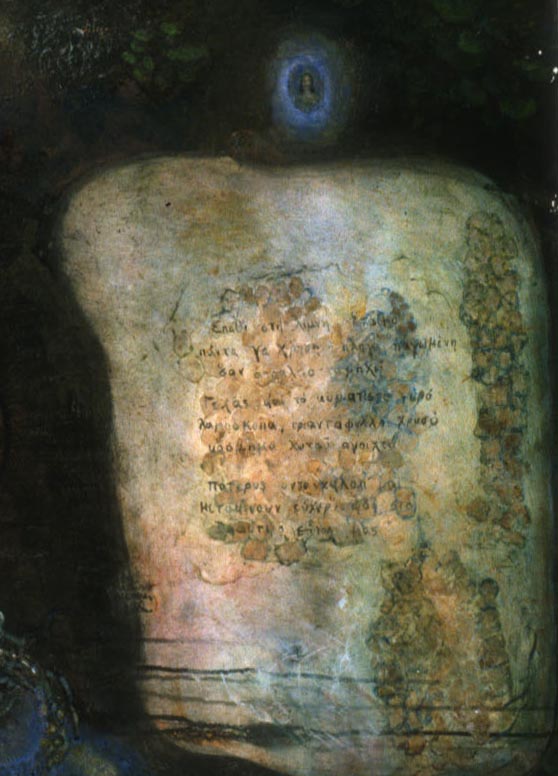 |
|
LVT:apv
III, Between Amherst and Delphi, detail, 1995
|
LVT:apv Amherst and Delphi
Anne Schuster Hunter, New Art Examiner, writes: "From figural interiors some years ago to more recent painterly improvisations, Frank Galuszka's canvases have been surfaces upon which, increasingly, anything can happen. His stylistic vocabulary ranges from representational to indexically actual, and covers the innumerable points of symbolism, decoration, regression and avant-gardism in between: elements of unease, something for everyone to love and hate on principle. Between Amherst and Delphi (LVT: apv II) is a tour de force through visual experience. One of the exhibition's three related figural works depicting the meeting of two women in a garden - one contemporary, and one the goddess Kali, the Shivite deity of destruction and sometimes renewal - its figures are smoothly, classically modeled in warm, saturated color. But the heavily worked canvas surrounding them provides both a a represented and a real miscellany: seed forms, insects, wax, and Greek letters, scrawled manuscripts on tissue paper (including fragments of an oddly punctuated poem), bits of mica, embedded and seemingly embedded cartouches and seals, a strangely glowing cobra, trompe-l'oeil dewy stones, pictograms disappearing and re-emerging on the laden surface. Clearly, Galuszka's is a heady art, perhaps informed by his studies in the inter connectedness of ideas and responses (he is a member of the American Society for Cybernetics). Yet his paintings avoid losing the viewer, perhaps because the glittering, oily, glowing beauties of the paintand the tiny, accumulating rewards of close perusal are too compelling. It is as if the painter's own desire to receive the impact of the painting is heightened in compensation for the intimidating multiplicity of visual codes. The rest of the series "LVT: APV" inevitably suggests an art historical progression. Wissahickon : La Vista Totale: A Partial View IV adheres most strictly to the classical enticements of figure painting, with complexions, rainbows, lilies and grotto rendered in a Giogione-esque glow. In La Vista Totale: A partial View III, the work has exploded into a mottled, heavy surface dominated by patterns and spreading pools of gilt within which the figures,corrupted by paint, are barely discernable. We seem to be following the dissolution of the illusory window of classical representation into its formal surface components, and thereby the liberation of personal, subjective response. But these paintings, provocatively, are numbered in reverse order. If the objective world was exploded by the cubists in 1912, and if art after 1945 liberated the subjective world from communicative intent, do we now go in reverse? Can object and subject be caught once again , or caught and freed over and over? Galuszka answers yes. Indeed, the figureless painting The Crickets (LVT: APV I), with its glorious, dense webbing of surface and illusion, comes even closer to inviting the viewer and viewed to an interlocked dialogue, representing the continuous breaking of the boundaries of subject and object that Galuszka's art promises.
- more -